Light front bomber and torpedo bomber Tu-14 (Part of 1) Creation
The need to switch to jet aircraft became quite obvious. However, the domestic engine-building, significantly lagged behind the world progress and could offer nothing for installation at all. Despite this, however, the development of aircraft equipped with turbojet engines began in 1945. For the first fighters used German captured engines BMW 003 and Jumo 004, the thrust of which was less than 1000 kgf.
At the initial stage, there were two trends: some design bureaus built aircraft taking into account the aerodynamic requirements of near-sonic speeds, others tried to adapt cars with outdated aerodynamics to the new powerplant. Both of these trends can be traced when designing fighters and bombers.
OKB Myasishchev initiated the transition to jet bombers. He proposed the PB-17 project with 4 RD-10 engines. However, the matter did not go further than the draft, since in the 1946 year, the OKB disbanded. Su-10 suffered the same fate. This machine was calculated under the four experimental TP-1, developed by the cradle design bureau. At this stage, the Ilyushin team advanced the farthest; it created an Il-22 bomber equipped with four TR-1.
The situation with aircraft engines improved significantly in 1947, after the UK acquired the Nin-1 and Derwent-V engines from Rolls-Royce, launched under the name of RD-45 and RD-500 in the series. "Dervent-V" had a single-stage turbine and a centrifugal compressor. With 14,7 thous. Rpm, the engine developed static thrust 1600 kgf. "Ning-1" differed from its predecessor by a two-way compressor. Designed and built in 6 months, it was tested in the fall of 1944. In the 1945, his thrust was brought to 2272 kgf at 12400 rpm, the specific fuel consumption at 727 kg was 1,08 kg / kg.s.
OKB Tupolev for a long time remained in the old positions. The design bureau made repeated attempts to improve the flight characteristics of the Tu-2 by installing more powerful and efficient engines. Also, the power plant of the aircraft tried to complement the turbojet engine. However, time has shown that this approach is a waste of energy.
In January, the design bureau 1947 began the development of a mid-range high-altitude bomber with a pressurized cabin and two Nin-1 turbojet engines. Two months later, the USSR Council of Ministers approved the construction of the 73 aircraft having absolutely fantastic data (range - 3 thousand km, speed - 850 km / h, bomb load - 3 tons) and unrealistic deadlines for state tests - December 1947 of the year!
Already at the design stage, it became clear that in order to obtain the specified characteristics, the thrust of two engines is insufficient, and it is possible that the aircraft will not take off at all, which would be an obvious embarrassment. Our aviation industry could not offer more powerful engines at that time, so the question arose of installing a third engine. The choice fell on "Derwent" (probably due to the lower mass), but the significant performance deterioration was not taken into account. It was assumed that the third engine will be used during takeoff and in emergency situations. To do this, in flight, the air intake of the engine off will be closed by a flap.
Fate
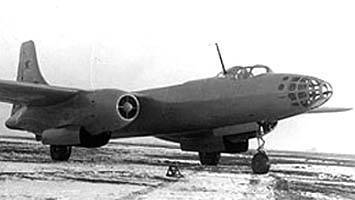 At first it was quite successful. 29.12.1947 crew test pilot Opadchego FF performed the first flight. By the middle of June, the 1948 of the year ended with factory testing. With a normal flight mass at an altitude of 5 km, the speed reached 872 km / h (M = 0,75), the practical ceiling (probably with the inclusion of the third engine) is 11,5 km, the range with a load of 3 tons is 1545 kilometers.
At first it was quite successful. 29.12.1947 crew test pilot Opadchego FF performed the first flight. By the middle of June, the 1948 of the year ended with factory testing. With a normal flight mass at an altitude of 5 km, the speed reached 872 km / h (M = 0,75), the practical ceiling (probably with the inclusion of the third engine) is 11,5 km, the range with a load of 3 tons is 1545 kilometers.The defensive armament of the 73 aircraft, about which they were very worried at the time, looked quite impressive: two pilot's 23-mm guns, due to the third engine, were forced to install the lower and upper two-gun remotely controlled installations. The leadership of the USSR was inclined to expand the mass production of this aircraft.
The aircraft had good stability and was easy to pilot. OKB-156 believed that the machine is ready for transfer to state tests. The latter looks rather strange, because the aircraft lacked the equipment necessary for combat use.
In August, 1948, during one of the flights to the crew of test pilot Opadchego FF (radio operator Khoroshev A.N., lead engineer Grozdov V.N.) succeeded, having dispersed the plane on descending from 10 to 7 km, to reach speeds of 920 km / h (M = 0,9).
In March, the Design Bureau of the Year 1948 was “punched” by a resolution of the Council of Ministers and the Central Committee of the CPSU, according to which Plant No.23 could build an experimental series of 10 bombers with RD-45 and RD-500 engines. In the series, these planes were to receive the designation Tu-14. Production of aircraft began, but due to the deployment at the plant number XXUMX production of twin-engine version of the machine it was stopped, and the reserve was transferred to Irkutsk.
Despite this, in August 1948 of the year, state tests of a semi-finished aircraft began, which lasted until May 1949. It was difficult to count them as successful: it was unstable, the engines, fuel system, etc. probably did. happened.
From the conclusion of the scientific research institute of the air forces it follows that the flight characteristics of the Tu-14 are in accordance with the resolution of the Council of Ministers from 31.05.1947, with the exception of the range that was less than that indicated on 190 km. Significant shortcomings of the front-line bomber were the lack of means of bombing out of sight of the ground, radio navigation equipment and anti-icing devices on the tail and wing, insufficient body armor protection of the crew, the different types of engines. As was to be expected, the observations turned out to be quite substantial, therefore, the plane had to be brought up.
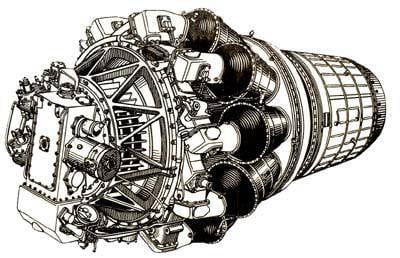 In the meantime, the Klimov Design Bureau created the VK-1 engine having a thrust of 2700 kgf. This was done by increasing the size of the Nin-1 engine and improving the flow path. Thus, the problem with the power plant was somewhat simplified, and the third engine was not needed on the plane. At this time, the Tupolev Design Bureau was engaged in fine-tuning a three-engine machine, in the version of reconnaissance "78" with one RD-500 and two RD-45.
In the meantime, the Klimov Design Bureau created the VK-1 engine having a thrust of 2700 kgf. This was done by increasing the size of the Nin-1 engine and improving the flow path. Thus, the problem with the power plant was somewhat simplified, and the third engine was not needed on the plane. At this time, the Tupolev Design Bureau was engaged in fine-tuning a three-engine machine, in the version of reconnaissance "78" with one RD-500 and two RD-45.The construction of the bomber "81" with two VK-1 engines began in accordance with the decree of the Council of Ministers of the year signed in December 1948. A modification of the machine "73". RD-500 engines were removed from the aircraft, radars were installed (PSBN-M is a blind bombing and navigation device), but due to an increase in crew to 5 people and for a number of other reasons, the project failed.
Some publications say that at a special meeting of the government in May 1949, the results of the tests of Il-28 and Tu-14 m, allegedly Stalin I.V. made a choice in favor of IL-28. But, apparently, this is not true. At the meeting, in particular, they discussed the issue of alteration of aircraft for VK-1 engines.
Tupolev, after three months, achieved a decision in his favor. In a resolution of the Council of Ministers signed in August by Stalin, 1949, in particular, it was noted that IL-28 aircraft would be discontinued and serial production would be prepared for the production of a Tu-14 bomber equipped with two VK-1 aircraft.
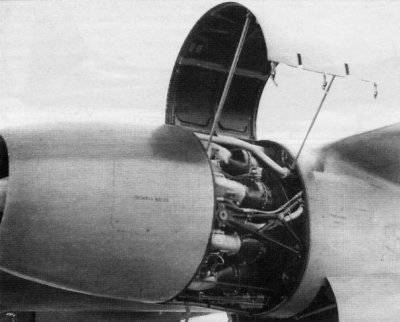 By the same decree, it was prescribed to immediately begin the transfer of a set of plans and drawings to the serial plant and to hand over the first 5 serial Tu-14 to September 1950. Thus, Tupolev found himself in an embarrassing situation: it was necessary to prepare production documentation without having a used aircraft.
By the same decree, it was prescribed to immediately begin the transfer of a set of plans and drawings to the serial plant and to hand over the first 5 serial Tu-14 to September 1950. Thus, Tupolev found himself in an embarrassing situation: it was necessary to prepare production documentation without having a used aircraft.Meanwhile, the Il-28 with the RD-45F turbojet engine, which was developed by the Ilyushin Design Bureau, initiated the tests in February, 1949, during which showed good results. By the fall of the Il-28, Ilyushin installed the VK-1 engines, whose mass production was launched at three plants.
By September, the 14 produced significant improvements on the Tu-1949: instead of the third jet engine, the KDU-81 rifle rifle unit was installed, equipped with the ASP-3P synchronous riflescope and airtight cockpit for the radio operator. To do this, the stabilizer was set at zero angle and the lower part of the steering wheel was cut off. Dismantled the lower and upper firing points. In the fuselage after that, there was another germocabine, an incomprehensible destination.
The crew again dropped to 3 people. The new version has been approved. To speed up the work, the 73 airframe was used, the diameter of the central and forward parts of the fuselage was increased, the stern was extended by 400 mm. An increase in the bomb bay provided suspension for the M-46 bombs. Also installed a synchronous optical sight OPB-6sr and typical bomb armament. On the plane, engine nesting was improved, which facilitated their maintenance.
In January 1950, the factory tests ended. They turned out to be satisfactory, but a large number of defects, which are subject to mandatory elimination, were revealed at state tests. These included the incompliance of the requirements of the Air Force with the angles of fire of the aft installation and the absence of all the crew members of the ejection seats.
The Civil Code of the Scientific-Research Institute of the Air Force in the third paragraph of the conclusion attempted to save the aircraft and the prestige of the company. It was noted that the Tu-14 on the flight data complied with the requirements of the front bomber. The aircraft was recommended for serial production and service in the versions of a torpedo bomber and a bomber with aft gun having the required firing angles and with the elimination of previously identified defects ...
At the plant No. XXUMX in the summer of 156, the aircraft was equipped with a modified aft unit, as well as anti-icing devices for the wing, air intakes of turbojet engines and tail unit. The extension of the fuselage on the 1950 mm in the area of the center section increased the cargo compartment, which probably pursued far-reaching goals. An air brake was installed under the hatch of the technical compartment, and a number of other changes were made.
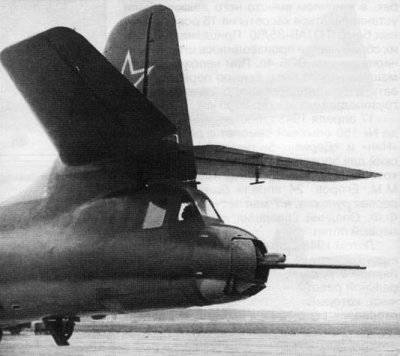 The tests of the aircraft presented to the customer in October 1950 of the year were completed in January of the year 1951. It was noted that the armament, the amount of equipment, the range of the Tu-14 with VK-1 engines meets the requirements of the air force and slightly differs from them in the ceiling and maximum speed. At the same time, the Tu-14 lost to the IL-28 at 57 km / h at maximum speed, its practical ceiling was less at 1,3 km, had the worst take-off and landing characteristics, and by rate of climb lost at 2 times.
The tests of the aircraft presented to the customer in October 1950 of the year were completed in January of the year 1951. It was noted that the armament, the amount of equipment, the range of the Tu-14 with VK-1 engines meets the requirements of the air force and slightly differs from them in the ceiling and maximum speed. At the same time, the Tu-14 lost to the IL-28 at 57 km / h at maximum speed, its practical ceiling was less at 1,3 km, had the worst take-off and landing characteristics, and by rate of climb lost at 2 times.Tupolev, saving the plane, turned to the naval the fleet, focusing on the bomb bay, which provided the suspension of aircraft mines and thermal torpedoes used small and large heights.
As a result of complex diplomatic quirks and "political" combinations, the following compromise point arose in the test report:
"Given that today a modern high-speed bomber, which allows for the suspension of mine-torpedo armaments, it is not possible to recommend the Tu-14 to mass production for arming naval forces using aerodromes with a runway longer than 2500 m.
Due to the large take-off distance and long take-off length, as well as the insufficient rate of climb, the Tu-14 plane cannot be recommended for use as a front bomber in the air force of the Soviet Army ... "
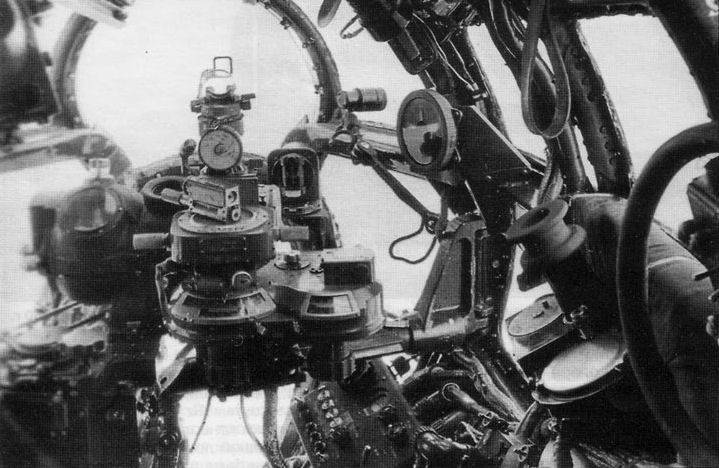
A similar decision was made with an absolutely obvious fact: the classic torpedoes have already outlived their age. However torpedo enthusiasts weapons there was still quite a lot. At the end of 1950, another revision was made on the Tu-14: a torpedo bridge was installed in the bomb bay, the necessary systems for preparing / dropping torpedoes were installed, the low torpedoing scope PTN-50 was installed in the navigator’s cabin.
At the NII-15 Navy in January, 1951 conducted control tests. Engineers Kukharenko V.D., pilots I.M. and Biba A.G. First, the tests were conducted at the airport LII, then in the Crimea. Vice-Admiral N.G. Kuznetsov, Minister of the Navy, and Preobrazhensky E.N., Commander of Naval Aviation, signed the conclusion in August 1951 with a recommendation to adopt the Tu-14.
As noted earlier, mass production began at the plant number XXUMX in Irkutsk. On the plane, intended as a torpedo bomber, the navigator's cabin glass was slightly modified to ensure the use of a torpedo sight.
According to the MAP of the USSR, the Irkutsk plant from 1951 to 1953 built 147 torpedo bombers Tu-14.
As part of the naval aviation by the beginning of 1951, there were 14 mine-torpedo air regiments (this does not mean that they actually were such as some units were armed with Pe-2 aircraft). On the Tu-14 was retrained five air regiments. In each of these, 30 airplanes should have been listed by state at the time. In fact, each regiment, except for combat aircraft, had 3 training IL-28. In addition, some regiments were mixed: one squadron on the IL-28 and two - on the Tu-14T.

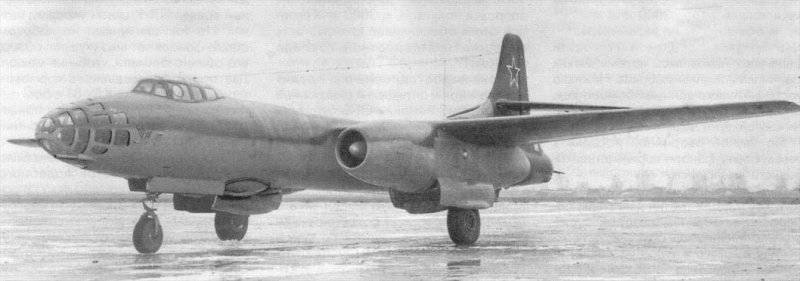
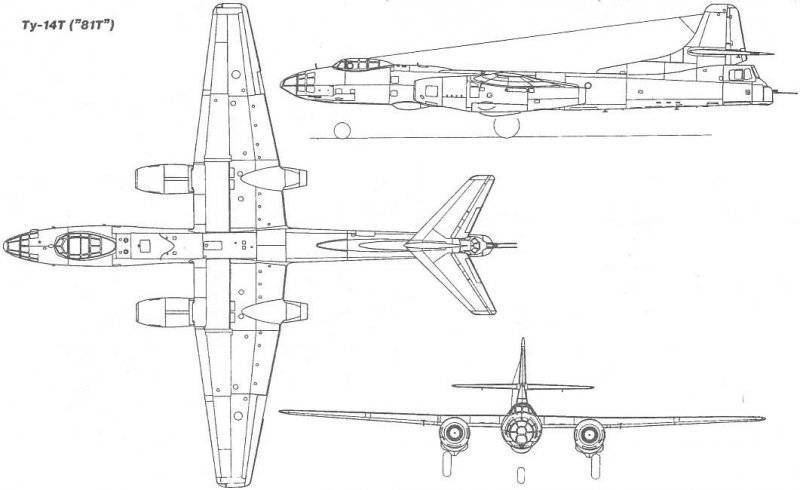


Information